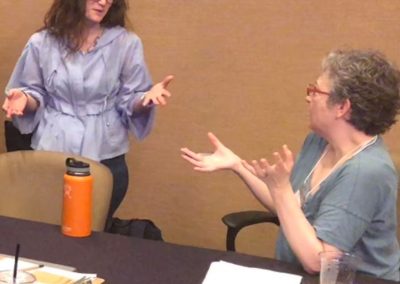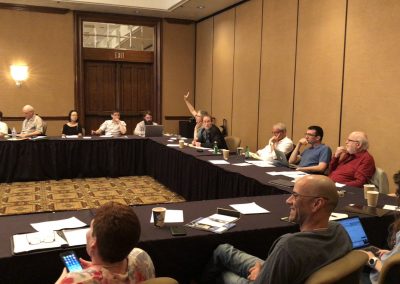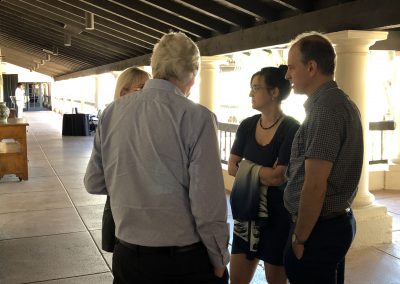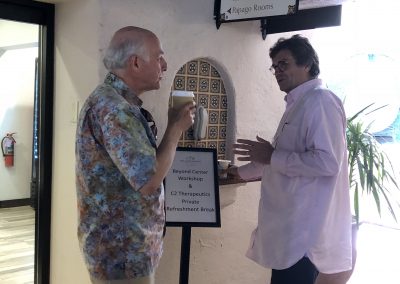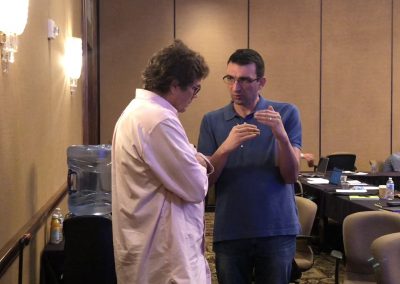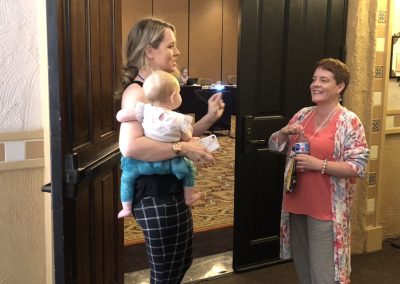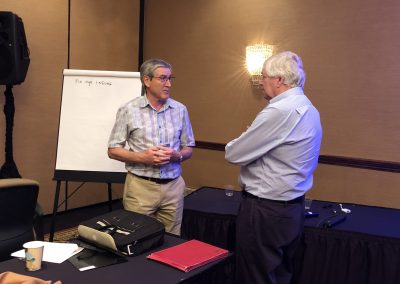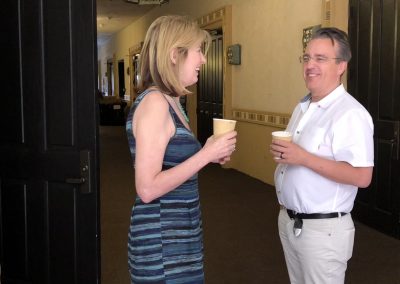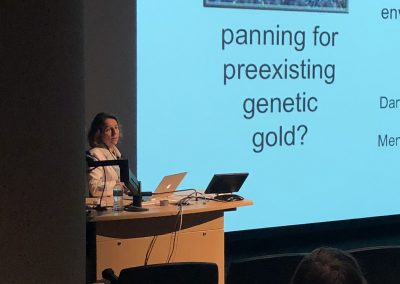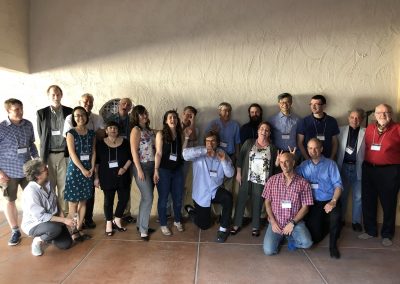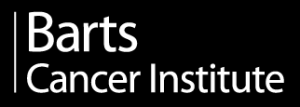Mon-Wed,
April 23-25, 2018
Scottsdale.
Cancer represents a breakdown in the regulatory mechanisms that mediate the relationship between individual cells and the organism as a whole, a relationship that dates back to the dawn of multicellularity over a billion years ago. Cancer may therefore be viewed as a throwback or reversion to an ancestral phenotype, providing a window on our evolutionary past. Studying the ages of human cancer genes and their homologs across many species provides important clues about cancer as a highly distinctive and ancient biological phenomenon. It also offers a fresh perspective on how to control it. The meeting brought together oncologists, microbiologists, evolutionary biologists, physicists and complexity theorists to identify how to best exploit the insights arising from this new perspective on the nature of cancer.
Audio
Interviews with workshop participants.
Thomas Bosch
Thomas Bosch from the University of Kiel in Germany leads a research team studying complex communities of bacteria and their intricate interaction with host organisms. Working with hydra – small, freshwater creatures found throughout the world – he discovered that very diverse communities of bacteria protect against tumors in the animals and conversely, reduced diversity allows the infiltration of pathogenic bacteria which can lead to tumors. And he believes these findings have relevance for human health.
Transcript: Thomas Bosch
Pauline Davies: What sort of organism is that? That’s a Hydra?
Thomas Bosch: Yeah, that’s a freshwater polyp, living around the world. In our laboratory, it lives in plastic containers, thousands of them in one Petri dish. We have clones and transgenic animals. It’s a completely molecularized model system for understanding basic features of multicellular life. In the last 15 years, there was a technological revolution. The technological revolution was that we were able, these novel machines, to deep, deep sequence and to discover that epithelia in the simple organism Hydra, as in any other organism on this earth, from plants to animals to human, all epithelia are colonized by microbes. This is not just that the microbes are sitting there, they form a complex community. This complex community in many cases is co‑evolved with the host tissue. If you remove that complex community then the host per se suffers, shows signs of diseases, for example. When we discovered that the Hydra epithelium is colonized by a stable microbiome, immediately the question came up, “So, what’s the function of that?” Then we not only were able to deep‑molecular analyze the Hydra tissue with molecular techniques, but also we were able to cultivate the bacteria in vitro, to make germ‑free animals and to re‑introduce the bacteria either as single species or in a complex community back to the host tissue. We started in the last 10 years, my lab and with a number of gifted postdocs and in particular Dr. Sebastian Fraune, Dr. René Augustin and Dr. Alexander Klimovich. We have tried to understand the impact of the microbiome on the host and, B, how does the host communicate with the microbiome? We discovered that there is basic transcription machinery which is necessary to maintain the stemness of the epithelium, particularly the transcription factor FoxO, which plays a crucial role in maintaining the microbiome by not only having target genes which belong to the stem cell machinery, but also to the antimicrobial peptides.
Pauline Davies: So you’ve got these microbes living on the hydra. Without the microbes, the hydra doesn’t do so well.
Thomas Bosch: That’s correct. They don’t do well in several aspects. The most obvious aspect is germ‑free animal suffers from pathogen attacks. Normally, animals can never be infiltrated by pathogenic fungi, but if the bacteria are removed, then the pathogen can infiltrate the epithelium.
Pauline Davies: Do you know how that happens or how the microbes are actually protecting the hydra?
Thomas Bosch: We still don’t know the precise antimycotic molecule. We know that it needs the complex community of the microbes. What that means is it needs a high diversity of the microbial community. That seems to be a common theme in the host microbe interactions, that sngle microbe bacteria species usually is not enough. They need a community. The community together then provides this effect and this protection to the host. All of that is important because it can get immediately put in context with modern diseases, which we call chronic diseases -inflammatory bowel disease, neurodermatitis, all the neural degenerative diseases which we think are caused by a dysbiosis in these microbes – some reason for that may be an excessive use of antibiotics. What the antibiotics do, as Martin Blaser (NYU Human Microbiome Program) shows very nicely, is they mostly reduce the diversity of the microbiome, for example, in our guts or in our intestine. By that, we have a reduced diversity of microbes which then is troublesome to us. The most important finding from this wonderful interdisciplinary cancer meeting here which I reported was the surprising observation some years ago that this continuously proliferating tissue which normally develops never any tumor or hypoplasia… Pauline Davies: This is the epithelium on the hydra? Thomas Bosch: Yes, the hydra tissue. A post-doc discovered a few polyps in our mass cultures which showed clear signs of tumor, so some years ago, we published the first description and analysis of these tumor‑bearing polyps and came up with a model as to how that happened. In those early days, we had already indication that the microbiome in these tumor‑bearing polyps is different from the wild type, but it was too early to put that in this single paper. So, a credit student in my lab, Kai Rathje, has spent the last two and a half years characterizing this tumor model in the context of the microbiome. What we astonishingly find is that the tumor tissue has a completely different microbiome. And, particularly, there is the presence of class of bacteria, which belong to the large group of spirochetes, and so there is a particular species of spirochetes which is then infiltrating this Hydra tissue. This infiltration at that early days of our analysis we found was correlated with the tumor. All tumor polyps had these spirochetes and wild‑type polyps never had these spirochetes. Then Kai did a number of function analysis including proving Koch’s postulate. One experiment was he applied a cocktail of antibiotics to hundreds of different individuals bearing tumors and in every single individual the tumor disappeared completely. That means by applying an antibiotic you somehow interfere with this tumor formation and the tumor is gone. The most critical experiment was when we had to cultivate these spirochetes which is not an easy task and succeeded. Then Kai did proving Koch’s postulate by injecting these spirochetes into healthy Hydra epithelia tissue. Sure enough, could cause in many cases, tumor formation. Then we knew the tumor can be caused by these spirochetes. The spirochetes are very pathogenic, have a secretion system…We still don’t know how it really works. At the end, the cytoskeleton of the epithelia cells is distorted and that leads then to this tumor type of bulk tissue. That may have then secondary consequences for the cells within that tissue which then also lead to over- proliferation. Something like that. Pauline Davies: These spirochetes are type of bacteria? Yes? Thomas Bosch: Right. Pauline Davies: With one of these curly tails? Thomas Bosch: Right. There are serpent-like and spirochetes come in mode these days because many ugly diseases are caused by them. Pauline Davies: Syphilis. Thomas Bosch: Syphilis, for example. Borreliosis (Lyme disease) is another one. Famous people in our history, composer Robert Schumann died of them. That’s a large group. All of them seem to be pretty nasty and have the same features. They grow very slow. You may carry them in your body long before you realize because they are there in low numbers. They seem to cause that. But the most interesting point was when we ask, “Why can spirochetes infect some polyps but others in our normal culture were never infected?” So the hypothesis came up that the natural microbiome, the microbes which are sitting outside the animal and which are co‑evolved with this animal may provide resilience, may provide protection. And we tested this idea by deliberately disturbing the natural microbiome either by temperature or these antibiotics. Sure enough, if you disturbed the microbiome and you disturbed the composition of the microbes present, it means the abundance of certain classes of microbes present in this mucus layer that allows the spirochetes to colonize then the tissue which otherwise is fully protected. Pauline Davies: What do you think is happening? Is it that the microbiome is actually providing the physical barrier or the other microbes somehow poisoning these spirochetes? Thomas Bosch: It’s an excellent question which we have no answer yet. Both possibilities are thinkable. One is the niche hypothesis that there is just no physical space if the natural microbiome is there and an intruder cannot colonize. Or alternatively, there is really an active defense against it. We don’t know yet, and we will test that. Pauline Davies: How would you relate this directly to, say, the human gut? Because what you’ve been saying some very interesting things like antibiotics kill tumors in Hydra. Could that conceivably work in humans? Thomas Bosch: Yes, I think so. We had a lively discussion after the talk. Due to the interdisciplinarity of this meeting here Mark Vincent, renowned clinical oncologist, informed me that some cases of colon rectal cancer, there is a distinct change in the biofilm in the colon in this area which has the tumor versus the area which does not have the tumor. So it seems also in the human gut that there is at least at the moment on the correlative level the tumor goes with a changed microbiome. We strongly believe that this can be, in many cases, a very general feature, that if you disrupt the natural microbiome by antibiotics or by something else, then that allows bad guys, bad bacteria to colonize and then may act pro‑cancerogenic and cause the tumor. We certainly will never say that all cancers are caused by microbial impact, but in some cases, this seems to be true and for me, we proposed some years ago this holobiont idea that any organism is a holobiont and that the microbes are actually – some colleagues call it the forgotten organ – an essential part of ourselves. You have to look for, what is the function of this organ in your body? One function is protection. I could tell you other functions which go into gut brain, neuro communication. But in terms of cancer, I think it’s a very nice example where healthy and the highly diverse natural microbiome may provide effective protection against potential cancerogenic bugs which are in the environment and waiting for getting a tissue to colonize but then cannot do much. But if our lifestyle or diet or antibiotics do change, this complex community of microbes, and by, for example, reducing diversity, this protective filter or layer may be damaged. Then we get vulnerable. That may be one of the reasons why certain cancers are getting more abundant in these days. Pauline Davies: Then you’ve got the cancer which, as you say, the antibiotics may have actually caused in the first place by killing of the microbiome. You’re proposing to treat with more antibiotics so that the tumors go away. Aren’t you back to square one? Thomas Bosch: Antibiotic certainly interferes with the complex microbiome. We manipulate the natural microbiome by using antibiotics. We clearly see that antibiotics have a dramatic influence on the natural microbiome. But this should never be used to advice against use of antibiotics in certain cases. Antibiotics are certainly an important invention. I referred to my colleague Martin Blaser of New York, who wrote this bestseller ‘The Missing Microbes.’ He studies the role of the antibiotics in our modern world in terms of microbiome that is just this excessive use of antibiotics, particularly in agriculture, in farming, in aquaculture, in plant breeding, which may be troublesome. And this is also direct comparison with people which are more native than we are. That we are compromising that with a reduced microbiome in our guts and reduced diversity of the microbiome. Not the absolute load. We have the same numbers of grams: you have probably two kilograms of bacteria in your gut. The important point seems to be the diversity. As I said in the beginning, the protection against the fungi cannot be provided by a single species of bacteria. It needs several species which cooperate together, either to make together that molecule, or one species has to induce the other species that this species then makes the critical molecule. It needs a complex community. That is in danger in the times of antibiotics.
Tomislav Domazet-Lošo
Tomislav Domazet‑Lošo is an evolutionary geneticist from the Ruđer Bošković Institute in Zagreb, Croatia. His talk, in which he explained why bacterial biofilms can be a good model for embryogenesis, stimulated much discussion. And he went on to claim that all life is so interdependent that it can never be regarded as unicellular.
Transcript: Tomislav Domazet Lošo
Pauline Davies: This meeting is about evolution and is about cancer and the mix between the two; how does your work fit into that?
Tomislav Domazet‑Lošo: To understand the cancer, we have to first understand its evolutionary origin. This is tightly linked to the complexity of multicellularity so to understand the evolution of multicellularity, I think it’s a pre‑requisite to understand the tumors. You cannot separate the two. On the other hand, if you think (about it), cancerogenesis is an evolutionary process in itself. So this is microevolution within the body. We cannot separate the two.
Pauline Davies: I know that you were saying some wonderful things about evolution; can you just summarize for me, what was the thrust of your argument? Out of all the things you mentioned, what would you like to pick out?
Tomislav Domazet‑Lošo: I think the most important part of my talk was related to the results, which show that the process of biofilm development at the system level is very similar to embryogenesis, what we see in animals. This maybe sounds very weird, that the process of embryogenesis or development which you see in animals in general has something to do with biofilm development in bacteria. But I show at the genetic level that the basic principles behind are the same.
Pauline Davies: Can you explain a bit more? What’s going on? Tomislav Domazet‑Lošo: For some time, people looking at bacterial biofilms are have been thinking of this as a developmental process. Can we really call this process a developmental process or is this just assembly of bacterial cells without some deep logic behind? To answer this, you could use methods which I and other people developed to study evolution and the phylogeny/ontogeny relationship in animals. So, for the first time, I applied these tools to the bacteria. They showed phylogeny/ontogeny correlations, which are also existent in animals. So, at the basic level, the basic principles behind developmental biofilms and development of embryos are the same. We can say they have a similar evolutionary logic behind.
Pauline Davies: Do you think that by studying bacteria and how they develop into biofilms, that would be an easier way into studying what’s going on in human development or animal development?
Tomislav Domazet‑Lošo: I’m confident that at least some phenomena could be studied by studying biofilms. To study the biofilms is probably easier in certain instances than to study the embryos. But, of course, you cannot completely shift to the bacteria – this is absolutely clear. But this universal logic of development – that’s something puzzling. That all life, bacteria life, multicellular animal life, plants, even fungi, they all have developmental processes which have some common rules behind. That’s very also important for biology in general. For example, in physics, it’s much easier to arrive at general rules than in biology. For that reason, biology, for some time, was considered like a big science, let’s say. Now we come to the deep system level understanding, which then can be applied to any biological system.
Pauline Davies: Why do you think people hadn’t thought before of using biofilms as a model for ontology in animals?
Tomislav Domazet‑Lošo: The problem was that first of all, people were not thinking that this is a real developmental process. People were thinking that bacteria are just unicellular organisms and that they don’t have anything which can be compared to the complex multicellularity we see in animals. That’s the first problem. But nowadays, when we have sophisticated genetic tools and the ability to look at all genes and their expressions, we can directly test these crazy ideas. It turned out that there are common rules behind. [laughs] That was the reason. [laughs]
Pauline Davies: In fact, I’m finding this afternoon and this morning, there have been quite a few talks about people dealing with bacteria and the gut biome ‑‑ stuff like that. This all seems to be very connected.
Tomislav Domazet‑Lošo: They are. Bacteria and human beings, we share 37 percent of genes. At the genetic level, we are talking the same language or a similar language. We understand each other. On the other hand, a lot of bacterial species are living on our surfaces. They communicate with us. They are even a part of our physiology. They play an extremely important part in our everyday lives and, of course, our evolution and our physiology in general.
Mark Vincent
Mark Vincent is a professor of oncology and a consultant medical oncologist from London, Ontario. His vast experience of treating cancer patients has led him to consider that tumor cells could, in some ways, be envisioned as a different form of life.
Transcript: Mark Vincent
Pauline Davies: You said you saw 10,000 or more cancers. This is mostly guts and lung.
Mark Vincent: Yes. I’ve been in this game for almost 25 to 30 years. It just occurred to me one day. In the clinic, I had an epiphany that these malignant growths that I was seeing in patients – either sticking out of their necks or on their chest x‑rays or CT scans – was not the same form of life that the patients were. It just occurred to me suddenly that what we’re seeing in this carcinogenesis process and the formation of tumors is really a speciation event. It didn’t seem to me to be the same thing as the host of origin, i.e. the patient. This led me on a journey of discovery and trying to figure out what, exactly, it was, which led me to a publication on cancer as a form of speciation. There’s a very conflicted literature on species and species concept and how to define species, especially in asexual organisms such as cancer cells. But it did seem to me, and I’m fairly certain now, that this is a kind of a speciation event, but not the usual kind of speciation event, and represents a form of life. And then, the next question was, where does this form of life reside on the tree of life? It’s not clear, exactly, what the answer to that is. Part of the talk was trying to figure out where on the tree of life, or what kind of form of life, is represented by cancer.
Pauline Davies: I think it was fairly close to where we are. At least, I saw fungi close to where that point of division was.
Mark Vincent: I came to the conclusion that probably the most parsimonious way to explain cancer was that it was a form of massive de‑differentiation to a more primitive state that we had gone through in the distant past, particularly the protozoic ocean where eukaryotic cells evolved, and that this wasn’t the usual type of speciation – for example, where you get a population of grasshoppers or fish that are separated and then can’t interbreed a hundred thousand years later, which is the usual form of speciation. But that this was really a whole jump to a different phylum or a different kingdom. Cancer cells are a type of protozoa and that this has happened very suddenly. This is a non‑classical form of speciation. It’s not the gradualistic form of speciation that we usually associate with Darwinism. This was a form of saltation, or large‑scale jump, into something that appeared to be primitive. The question is, why is it primitive? It looks unicellular and it has certain phenotypic traits that seem to be inherently primitive, such as genomic instability or such as hypoxia tolerance, proton pumping, Warburg metabolism and so on, which might represent adaptations to the protozoic oceans, which had a very different geochemistry than the modern oceans and the modern climate today. So it seemed to tie in from a number of different speculative points, that this cancer represented, in fact, a kind of massive jump backwards to the point on the tree of life just after fungi had separated but before the various metazoan species had branched out in the Cambrian explosion. It seems to me that really what we’re seeing is a living fossil from the protozoic, and that this is a unifying hypothesis as to what previously seemed to be mysterious about cancer. This seemed to be an answer to it. It was really speculative. But part of the talk was looking at the work of David Good and Tommy (Tomislav Domazet Lošo), who basically had shown that some of these ancient eukaryotic unicellular genes were, in fact, over‑expressed or re‑expressed in cancers. And the multi‑cellular genes may have been down‑regulated, which was really consistent with this whole idea. So it’s very gratifying to see that the speculations may, at last, have been backed up by other people’s hardcore science.
Pauline Davies: You’re a clinician, so presumably, you want to use this knowledge in some stage to help people. How do you think the atavism theory can actually help?
Mark Vincent: This is a crucially important question for the whole field of atavism because once you can show that there’s some practical utility to it, then, I think, the world will become highly interested in it and dollars will flow and we’ll be able to do more and better and deeper science. So I have published a paper recently in “BioEssays” called “Cancer: Towards a General Theory of the Target” https://onlinelibrary.wiley.com/doi/full/10.1002/bies.201700059 which doesn’t talk about atavism particularly, but talks about the whole landscape of cancer therapies in a reductionist way and that treatments can be one of two sorts. They can either block to causal chain that’s driving the cancer every day or they can be based on recognition of a mark or a signature, such as surgery or radiation or chemotherapy, where it simply exploits some kind of signature difference between cancer and normal tissues., and any kind of treatment boils down into either of these two. And then the question is, from an atavistic point of view, how does this apply? With David Good’s work showing that there’s a whole lot of unicellular genes, which are reactivated and re‑expressed. Some of those I think are driver genes in the sense that they construct the cancer cell and are probably driver targets or causality type targets which can be inhibited to good effect. On the other hand, there’s a whole lot of signatures – again, such as hypoxia tolerance, there’s very low acid pH in the extracellular milieu of tumors, Warburg metabolism, reactive oxygen species sensitivity, and so on – which are signature differences between cancer and normal cells which fall into the atavistic paradigm, but which can be exploited by some cunning way of bringing a destructive process that can be triggered or enabled by this different signature. So not only do you get destruction of the tumor cells but you also get it selectively, which is the two key elements of any effective therapy is that it’s got to reduce the number of tumor cells that would have happened and it’s got to do it selectively so that it’s not intolerably toxic.
Pauline: So those are two mechanisms, but can you see them actually making a difference? How would you use those?
Mark Vincent: For instance, people have stumbled upon this empirically without initially knowing it, so that in a colonial growth, tumor cells can be seen as colonies. What we call tumors are, in fact, primitive colonies of almost unicellular type cells but in some kind of aggregate, and surgery exploits that. We know that large numbers of people with breast cancer, colon cancer, and even lung cancer and so on can be cured simply by surgically removing the tumor. In a way, you’re exploiting the fact that these things tend to grow in colonies rather than immediately disseminate. Of course, a lot of cancers do metastasize and do come back, but you can cure an amazingly high proportion of people with simply cutting out the tumor or irradiating it because it grows in a colony and the metastases are either ineffective or haven’t yet happened. That’s one simple way. Genomic instability, for example, which is a hallmark of cancer, results in tumors expressing what are called new antigens or, at least, foreign‑looking proteins. The immune system now becomes alerted. And one of the big areas of progress in cancer therapy is the application of immune checkpoint inhibition which releases the immune system and which can now be enabled to act on cells that are expressing these new antigens. And these are highly effective in tumors that have so called high tumor mutational burden, which is the correlate of the underlying genomic instability. There are other people who are looking to target packages of drugs based on low pH in the tumor milieu so that the carrier with dissolve and release these very toxic chemicals but only in the milieu of the tumor.
Pauline Davies: Which are always much more acidic.
Mark Vincent: Yeah – which are much more acidic in the extracellular milieu. This is something that cancer cells do and has been poorly understood and poorly appreciated but is an obvious gross difference between most tumors and normal tissues and can be used to target toxic drugs selectively to tumor areas. It shouldn’t be seen as an obstacle but should be seen as an opportunity.
Pauline Davies: So many different possibilities. We’ve got to go into the meeting, but thank you very much.
Mark Vincent: Thanks for the opportunity. It’s always great to talk about this with all these folks. It’s a real privilege to be part of this community.
David Goode
David Goode leads the Computational Biology Program at the Peter MacCallum Cancer Center in Melbourne, Australia where his group studies the evolutionary forces governing the formation of tumors and their responses to therapy. He spoke about how he applies network theory to his work.
Transcript: David Goode
Pauline Davies: In fact, I remember that you think that the fundamental drivers of cancer are those particular control genes when they go wrong.
David Goode: That’s right. You have these extra layers if you will that have evolved over time if you can imagine concentric circles. But what’s really key is that you have these genes that link the inner layers, these unicellular genes with outer layers, these multicellular genes. In an ordinary cell, these multicellular genes then are integrating signals from outside to control the inner unicellular genes. What happens in cancer is you have some disruption of what we call the interface genes, those genes that are in between the outer multicellular layer and the inner unicellular layer. And when that happens, those unicellular genes can become activated inappropriately and this would allow tumor cells to grow and divide unchecked.
Pauline Davies: So the structure you’re envisaging is the unicellular genes from when it was very simple life on Earth and then multicellular genes was much more complicated and organisms started to develop. And then it’s that combination – bringing them both together – that you need to regulate and that goes wrong? Is that what I’m stumbling through?
David Goode: Yes. Basically, in the human genome, you’ve retained those genes that originally arose in unicellular organisms, but you’ve added a lot more genes to control them and manipulate them. It’s those genes then that are targets for mutation and cancer. When you mutate those genes and you knock out their function, then what happens is the communication gets all messed up and then tumors can then activate genes that are normally suppressed in a regular human cell.
Pauline Davies: Is this just a theory or is there evidence that it’s correct?
David Goode: So that’s what we’ve been working towards. And we’ve been doing that by looking at mutation data from seven solid tumors. We’ve been looking to see if the mutations tend to occur in what we call in our interface genes, the genes that control communication between the multicellular and the unicellular genes. What we’re finding is that indeed they do. When we look for recurrent mutations which are mutations that occur in multiple tumors, we see that they tend to be enriched in these genes that control communication between multicellular and unicellular genes.
Pauline Davies: How do you know the ages of the genes?
David Goode: There’s been a lot of work in the past done on sequencing genomes of a variety of organisms from simple bacteria all the way up to human and various other mammals. So we can tap into that information: we can compare the sequences of genes from multiple organisms. We can see for each human gene how far back can you go and still have a clear, what we call an ortholog, so a gene that has enough sequence similarity that suggests a common origin. So we can go back through the tree of life and see how far down can we go and we still have a conserved copy and ortholog of that gene. That’s how we apply ages to our set of human genes.
Pauline Davies: These regulatory genes, are they relatively recent then?
David Goode: No, not necessarily. A lot of them are present in very simple multicellular organisms like sponges or starfish or sea urchins, so that suggests that they’re quite old, that a lot of them arose potentially very early on in multicellular life – the first marine multicellular organisms had copies of these genes, maybe not exactly the same copy but something very similar.
Pauline Davies: Will these ideas…Can they help in any way actually, treat or prevent cancer? Are you doing something that isn’t already being done by other mechanisms or techniques?
David Goode: That’s something we’re definitely working towards. What is important and what motivated us in part to look at this is that in a given tumor you will have hundreds or thousands of mutations. It’s not clear which ones of those are actually the most important, which ones are what we call drivers that are actually causing the tumor to form and to proliferate. So with this framework we think we can do a good job then of identifying potential drivers within patients’ tumors. That could potentially give the clinicians a handle on which genes they should be looking to target with drugs in those tumors. The other thing is if we’re looking at our gene regulatory networks we can see what genes are being controlled by these interface genes. When they get mutated those processes go haywire, and that’s also a potential point where we could intervene medically. If you see a pathway gets upregulated when it shouldn’t, maybe you can try to pharmacologically inhibit that pathway to try to push it back down to where it should be.
Pauline Davies: This sounds like very, very basic research but yet you’re working in a hospital situation. Do you have a lot of contact with clinicians?
David Goode: ] I do. We have a lot of labs that are run by what we call clinician researchers so they have an MD and a PhD. They spend part of their working life seeing patients and part of their working life running a scientific laboratory. What’s really great about working with people like that is that they have both a perspective of science and medicine. You can get a lot of ideas about how to turn certain basic research into clinical advances. And they are very often good for coming up with ideas of how you can turn your discoveries into something that’ll be useful in the clinic.
Pauline Davies: Finally, have you enjoyed this meeting so far?
David Goode: Definitely. What I’ve really enjoyed is getting a lot of different, diverse perspectives from a variety of scientists that I might not otherwise get a chance to interact with. Getting a lot of new ideas, so it’s been very enjoyable from that perspective.
Pauline Davies: And hopefully made a lot of new friends. [laughs]
David Goode: Definitely. It’s a very collegial atmosphere and I really like that. I like the debate and that kind of activity that takes place during the talks. A lot of conferences are so big that you get up on stage, you give your talk, maybe a couple of people ask questions, but there’s not really time to explore any ideas in detail. A smaller workshop like this is definitely very good for thinking more critically and more deeply about all these issues surrounding cancer research.

